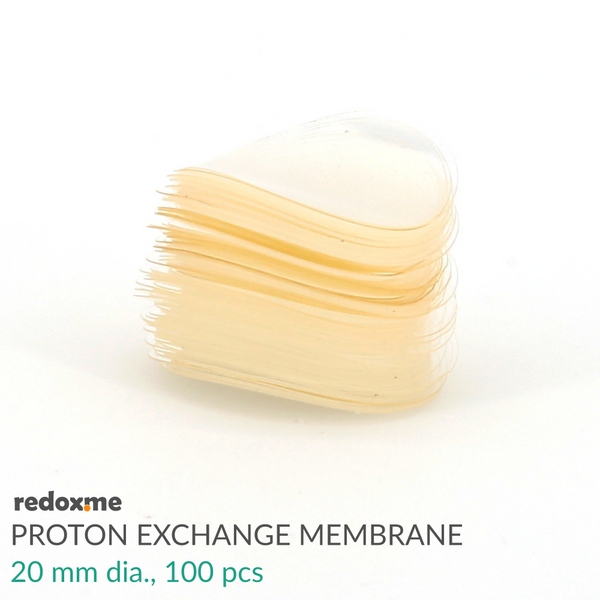Nanoporous PFAS-free Polymer Membrane (pack of 10)

Increasing regulatory scrutiny and restrictions on the use of PFAS compounds in various applications, including membrane manufacturing, make PFAS-free alternatives more attractive from a compliance standpoint. Using PFAS-free membranes ensures adherence to current and future regulations, avoiding potential legal and reputational risks associated with using PFAS-containing materials. Nanoporous PFAS-free membranes are widely used in electrochemical cells to separate the working electrode and the counter electrode. These membranes play a crucial role in such setups by allowing the passage of ions while preventing the direct contact of the electrode with products appearing at the other electrode. By physically separating the electrodes, nanoporous membranes prevent the mixing of electrolytes or reaction products between the working and counter electrodes, which can interfere with the desired electrochemical processes. This separation is essential for controlling the electrochemical reactions occurring at each electrode and maintaining the integrity of the cell. Nanoporous membranes can be further engineered to selectively allow certain ions to pass through while blocking others. This selectivity is vital for controlling the movement of ions within the electrochemical cell. Nanoporous membranes provide aloso a large surface area for ion exchange, which can enhance the efficiency and performance of the electrochemical cell. Nanoporous membranes are available with various pore sizes, surface chemistries, and thicknesses to meet the specific requirements of the electrochemical system, such as optimizing ion transport and minimizing resistance.
Available Nanoporous PFAS-free Membrane materials are Polyethersulfone (PES), Mixed Cellulose Ester (MCE), Polyamide (Nylon), Cellulose Nitrate (CN), and Cellulose Acetate (CA). Nanoporous PEEK Membranes available on other product page are also PFAS-free.
Application note
PFAS-free membranes are often preferred over PFAS-containing membranes for electrochemical applications mainly due to Environmental and Health Concerns. PFAS (per- and polyfluoroalkyl substances) have raised significant environmental and health concerns due to their persistence, bioaccumulation, and potential toxicity. PFAS-containing membranes can contribute to the release of these harmful substances into the environment during production, use, and disposal. In contrast, PFAS-free membranes eliminate the risk of exposure to these substances, aligning with sustainability and health-conscious practices. PFAS-free membranes can exhibit comparable or even superior performance characteristics, such as ion selectivity, permeability, and mechanical strength, compared to PFAS-containing membranes. PFAS-free membranes can offer comparable or superior chemical inertness compared to PFAS-containing membranes. This inertness is crucial in electrochemical applications, where the membrane needs to withstand exposure to corrosive electrolytes and maintain its structural integrity over time. PFAS-free materials, such as certain polymers or ceramics, can provide excellent chemical stability without relying on potentially harmful PFAS compounds. PFAS-free membranes may offer better long-term stability and reliability, as they do not degrade into potentially harmful byproducts over time. This characteristic is particularly important in electrochemical applications where the membrane's integrity directly impacts the performance and lifespan of the cell.
These membranes are typically used to separate compartments in H-cells filled with aqueous or organic electrolytes and are ideal for organic electrosynthesis, electrolysis, fuel cells, batteries, biomolecule separation, membrane catalysis, etc. They are cut to the desired size using a laser and are also available in sheets.
Specification
shape: round
diameter [mm]: 25
color: white
pore size [nm]: 220 (PES, MCE, Nylon, CN, CA)
wettability: hydrophilic (PES, MCE, Nylon, CN, CA)
thickness [μm]: 120-130 (PES), 100-150 (MCE, CA), 100-110 (Nylon), 100-140 (CN)
bubble point [psi]: 51-60 (PES), 51-68 (MCE), 45-57 (Nylon), 43-54 (CN), 41-60 (CA)
flow rate at 10 psi [mL/min/cm2]: 21-27 (PES), 22-43 (MCE), 4-5 (Nylon), 32-44 (CN), 19-40 (CA)
Intrastat data
HS Code: 39209990
Country of Origin: Sweden
NET weight: 100 g
Product includes
10 pcs of Nanoporous PFAS-free Membrane of selected material
Related products
H-Cells





